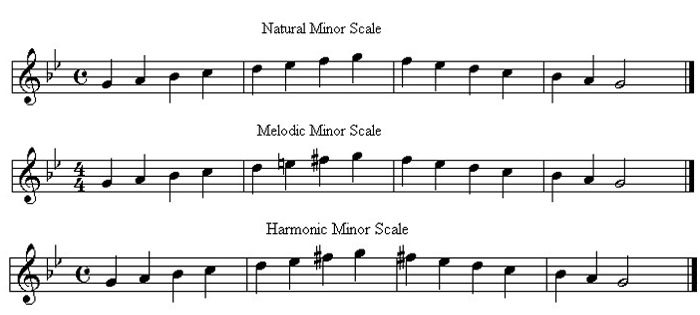harmonic minor scale

The scales of G natural minor, G melodic minor, and G harmonic minor.

Guitar tab for G harmonic minor.

Guitar tab for G harmonic minor.
The harmonic minor scale is one of the three main kinds of minor scale, along with the natural minor and the melodic minor. It differs from the natural minor in only one respect – its seventh note is sharpened so that it lies only a semitone below the tonic.
The step-pattern of the harmonic minor scale is:
tone, semitone, tone, tone, semitone, augmented second (one a half tones), semitone
An augmented second is an interval of three semitones, which in a scale is very wide gap. It gives the harmonic minor an Arabic feel to it. In fact, it is sometimes called the Mohammedan scale because the notes of its upper tetrachord are also commonly found in Arabic music.
Playing and harmonizing the G harmonic scale
Take the G harmonic scale as an example. The notes of the G harmonic scale are G, A, B♭, C, D, E♭, F♯. The finger positions for these notes, starting at the third fret of the guitar, are shown on the tab above. To the right are shown the triads built from the G harmonic scale: G minor, A diminished, B flat augmented, C minor, D major, E flat major, and F sharp diminished. A suitable progression of these chords played at the same time as a melody of notes picked out from the scale will sound harmonious, and tend to have a Spanish or Arabic flavor to it.
How the harmonic minor scale came about
The harmonic minor scale evolved as a result of the principles of harmony applied to the construction of chords. A chord can be built on any note of a scale, but the most important are those built on the first note (the tonic or I chord) and the fifth note (the dominant or V chord). One of the three notes that goes to make up the dominant chord is the seventh note of the scale. In the major scale, the seventh note is a semitone below the tonic. But in the natural minor scale, the seventh note is a whole tone below the tonic. This means that dominant chords built on the 5th notes of major and natural minor scales don't have the same effect. To overcome this problem the seventh note of the natural minor scale is raised (sharpened) by a semitone, giving rise to the harmonic minor scale.
Other scales derived from the harmonic minor
Several common scales in the Middle East derive from the harmonic minor. These include the Hungarian minor (or gypsy minor), which is a mode of the fifth degree of the harmonic minor; the Ukrainian minor (a mode of the fourth degree); and the Hiram scale (a mode of the third degree).


